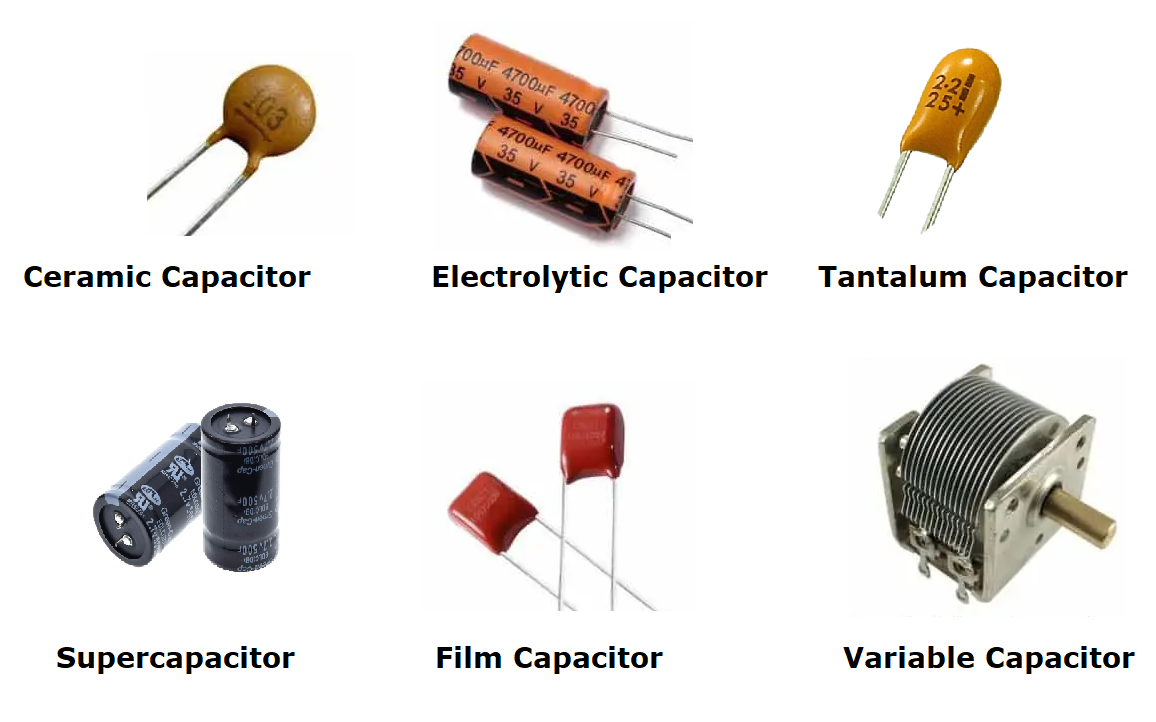Capacitor
What is mean by capacitor?
A capacitor is an electronic component that stores electrical energy in an electric field. It consists of two conductive plates separated by a non-conductive material or dielectric. When a voltage is applied across the plates, it creates an electric field between them, and electrons are stored on the plates, creating a charge. The capacitance of a capacitor, measured in farads (F), is a measure of its ability to store charge. Capacitors are used in many electronic circuits for a variety of purposes, such as storing energy, filtering noise, and blocking DC while allowing AC signals to pass. They are also used to smooth out power supplies, bypass signals, and tune oscillators. Capacitors come in different types and sizes, each with their own characteristics and applications, and they are essential components in many electronic circuits.
Electrical symbol of capacitor
The electrical symbol for a capacitor is two parallel lines representing the conductive plates, with one shorter than the other, and an arc or squiggle above them to represent the dielectric material. Here is an example of the symbol:

The longer line represents the positive terminal of the capacitor, and the shorter line represents the negative terminal. The arc or squiggle above the lines represents the dielectric material that separates the plates. The symbol may also include a letter that represents the capacitance value in farads (F), such as "C" or "F".
Capacitance
Capacitance is a measure of a capacitor's ability to store electrical charge. It is measured in units called farads (F). The capacitance of a capacitor is determined by the size and distance between its conductive plates, as well as the type of dielectric material used to separate them.
Capacitance is an important parameter in electronic circuits, as capacitors are commonly used for filtering, timing, and energy storage applications. Capacitors with different capacitance values are used for different purposes in electronic circuits, and selecting the appropriate capacitance value is essential for proper circuit operation. Capacitance values can range from picofarads (pF) to farads (F), with smaller values used in high-frequency applications and larger values used in energy storage applications.
Formula
The formula for capacitance is:
Capacitance is directly proportional to the amount of charge that can be stored on the plates of a capacitor for a given voltage. In other words, the greater the capacitance, the more charge can be stored.
[$$:]C = \frac{Q}{V}[:$$]where:
- C is the capacitance, measured in farads (F)
- Q is the charge stored on the plates, measured in coulombs (C)
- V is the potential difference between the plates, measured in volts (V)
Another formula that relates capacitance, plate area, distance between plates, and the permittivity of the material between the plates is:
[$$:]C = \epsilon_r \cdot \frac{A}{d}[:$$]where:
- C is the capacitance, measured in farads (F)
- [$:]\epsilon_r[:$] (epsilon sub r) is the relative permittivity of the material between the plates (also known as the dielectric constant)
- A is the area of the plates, measured in square meters (m²)
- d is the distance between the plates, measured in meters (m)
Serial and Parallel circuit
Serial and parallel combination are two ways of connecting multiple capacitors together in an electronic circuit.
In a serial combination, the capacitors are connected end-to-end, so that the positive terminal of one capacitor is connected to the negative terminal of another capacitor. The total capacitance of the combination is calculated by the formula:
1/Ctotal = 1/C1 + 1/C2 + 1/C3 + ...
Where Ctotal is the total capacitance, and C1, C2, C3, etc. are the individual capacitances of the capacitors in the serial combination. The total capacitance of a serial combination is always less than the capacitance of the smallest capacitor in the combination.
In a parallel combination, the capacitors are connected side-by-side, so that the positive terminals are connected together and the negative terminals are connected together. The total capacitance of the combination is calculated by adding the capacitances of the individual capacitors:
Ctotal = C1 + C2 + C3 + ...
Where Ctotal is the total capacitance, and C1, C2, C3, etc. are the individual capacitances of the capacitors in the parallel combination. The total capacitance of a parallel combination is always greater than the capacitance of the largest capacitor in the combination.
Serial and parallel combinations are used in electronic circuits for different purposes. Serial combinations are used to increase the effective voltage rating of a capacitor or to create a specific capacitance value by combining capacitors of different values. Parallel combinations are used to increase the total capacitance of a circuit or to create capacitors with specific capacitance values by combining capacitors of the same value.
Types of Capacitor
There are several types of capacitors available, each with different characteristics and applications. Here are some common types of capacitors:
Ceramic Capacitor: This type of capacitor is made of ceramic materials and is widely used in electronics for decoupling and bypass applications. They are small in size, have a low cost, and are available in different capacitance values.
Electrolytic Capacitor: This capacitor uses an electrolyte solution to achieve high capacitance values. They are polarized, meaning that they have a positive and negative lead and must be connected correctly in a circuit. Electrolytic capacitors are commonly used in power supply circuits.
Tantalum Capacitor: This capacitor uses tantalum metal as the anode material and has a very high capacitance per volume ratio. They are polarized and have a high reliability, making them suitable for use in circuits with high stability requirements.
Film Capacitor: This type of capacitor uses a thin film of metal deposited on an insulating material to achieve its capacitance. Film capacitors have a low leakage current and are commonly used in audio circuits and power supply applications.
Supercapacitor: This is a type of capacitor with a very high capacitance value and energy density. They are used in applications where a large amount of energy needs to be stored and delivered quickly, such as in electric vehicles and renewable energy systems.
Variable Capacitor: This type of capacitor allows for the adjustment of its capacitance value. They are commonly used in tuning circuits in radios and televisions.

These are just a few of the many types of capacitors available, each with its own unique characteristics and applications.
User Comments
No Posts found !Login to Post a Comment.